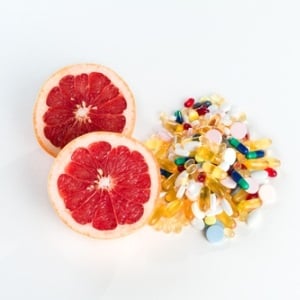
A recent article (High Nutrient Intakes from Beverages, Foods & Supplements Raise Concerns) published on the Natural Medicines website, has once again underlined how important it is to warn members of the public not to overdo their micronutrient intake.
A little is good, but a lot can be dangerous
I have often pointed out to the public that consuming small amounts of vitamins, minerals, trace elements, phytonutrients and essential fatty acids as specified in RDAs (Recommended Daily Allowances) or NRVs (Nutrient Reference Values) or Suggested Intakes, is important for life and good health. I have also repeatedly warned against overdosing because this can cause serious harm.
For people who live on a monotonous staple diet, some provision is made in South Africa to supplement micronutrient intake by means of fortification of wheat flour and maize meal with 6 vitamins, namely vitamins A, B1, B2, niacin, pyridoxine, folic acid, and two minerals, iron and zinc.
Read: To supplement or not to supplement?
For the more affluent members of our population who can afford a greater variety of food, most of the micronutrients they need should be available from their diet, provided it is balanced and they are not in a phase of rapid growth or recovering from a serious illness. When there is an added requirement for nutrients, supplements can be used until the deficiency has been eliminated.
Supplement use should preferably be initiated and supervised by a medical doctor or a registered dietician. The use of supplements should not be based on recommendations made by your gym instructor, sports coach, beautician, hairdresser, pharmacy assistant, or anyone else. All these supposed “experts” are generally not trained in the field of nutrition and are touting supplements to make money, not improve your health or sports performance. Media advertisements also bombard us with the need to supplement our “deficient” modern diets, but at the end of the day, their purpose is to sell a product.
I am sure that the majority of these so-called “supplement punters” are not aware of the fact that certain micronutrients when taken in excess can be harmful and cause irreparable damage to your body – or that having an unbalanced intake can also have negative effects.
But the myth that “if a bit is good for me, then more is even better” is constantly being applied to supplements all over the world. Many people firmly believe that they need to take supplements over and above the vitamins and minerals they are already ingesting through the fortification of practically everything we consume.
Beverages bursting with vitamins
A study was recently conducted in Canada by Dachner and co-authors to determine what effect a change in regulations had had on what they call “the novel beverage market”. This consists of liquids such as bottled water, fruit juices, vitamin waters and energy drinks, all of which contain added nutrients ranging from vitamins to omega fatty acids. These beverages are also popular in South Africa.
These researchers found that on average the 46 products they examined each contained 4,5 added micronutrients, with vitamins B6, B12, C and niacin being the most common additives. In addition, most of these added nutrients were present in quantities that far exceeded the recommended quantities. The labels on these beverages promised an array of benefits to users, some of which were clearly unproven.
Read: Water better than sports drinks
In a country such as Canada, young adults, who are the people most likely to consume these vitamin-loaded beverages, are not deficient in micronutrients, with the possible exception of vitamins A and C.
Consequently we have a situation where manufacturers of these drinks are adding multiples of the RDA or NRV of a variety of micronutrients to their products, without taking the actual needs of their target population into account. For example, I can imagine that one of the reasons why the novel beverage market manufacturers are not adding vitamin A to their drinks is that this is a relatively expensive supplement. The potential danger of hypervitaminosis A may also play a role. Vitamin C, on the other hand is inexpensive, and it is therefore puzzling why Canadian manufacturers don’t add moderate quantities of this vitamin to their novel drinks.
A growing problem
Other researchers such as Datta and Vitolins in the USA identified the problem of over-supplementation in 2014, when they pointed out that modern Western populations are ingesting micronutrients at an unprecedented rate and in unbalanced quantities. Nutrition experts are concerned that those of us who are not living below the breadline may well be drowning in an ocean of added micronutrients.
In South Africa you can get quite exhausted walking down the aisles of supermarkets, mega-stores and large pharmacies, lined with hundreds, if not thousands of supplements laced with excessive quantities of vitamins, minerals, and trace elements, amino acids and omega fatty acids – all promising you health, beauty, top performance on the track, in bed, during exams or your job.
Read: Do you take daily supplements to boost your immune system?
I, therefore, strongly suggest that people take stock of what they are consuming. Take the time to look through your kitchen and medicine cupboards and haul out all the foods and products that contain added vitamins, minerals, trace elements, phytonutrients, and essential fatty acids. Line these items up and add up for example the quantities of niacin aka nicotinic acid or nicotinamide (vitamin B3).You’ll be blown away by how much niacin you are ingesting from your standard supplements, your sports supplements, your vitamin water, bottled waters, energy bars, etc. And remember that this is in addition to the amounts consumed in your regular diet.
The daily requirement of vitamin B3 is about 16 mg per day for adults. Fortunately niacin has a low toxicity, but you might actually be swallowing up to 10g a day!
Read: New research on niacin
According to Mahan, doses of niacin exceeding 1 to 2g per day can cause a release of histamine in the body which may cause flushing and be harmful to individuals suffering from asthma and ulcers. Too much niacin can also be toxic to the liver. So, although niacin is one of the micronutrients that is sometimes used to reduce high blood cholesterol levels, keep in mind that the warning that “Megavitamin use should be monitored carefully because high doses act as drugs and not nutritional supplements”.
Niacin is a relatively low-risk micronutrient, but fat-soluble vitamins (vitamins A, D, E and K) and heavy metals (zinc, chromium, selenium) are potentially toxic if ingested in large quantities.
How to reduce your intake
If you are flooding your system with a cocktail of micronutrients on a daily basis, please reduce your intake gradually as your system will have become accustomed to excessive levels. For example, if you have been ingesting more than 1000mg of vitamin C a day (which can lead to the formation of kidney stones), stopping such a high intake abruptly could make you susceptible to colds and flu. You need to gradually taper off your intake over a number of weeks until your body has adjusted to a more normal intake of about 70 to 100 mg of vitamin C per day.
Tread carefully when you buy anything that contains “added vitamins and minerals”, and do a regular inventory of your micronutrient intake to prevent overdosing. The very word “micro” indicates that we require small quantities of these nutrients.
Read more:
Vitamin supplements could be harmful
Are vitamin supplements fatal?
Your vitamin supplement may not work
References:
- Dachner N et al (2015). An examination of the nutrient content and on-package marketing of novel beverages. Appl Physiol Nutr Metab. 40(2):191-8.
- Datta M, Vitolins MZ (2014). Food fortification and supplement use – Are there health implications? Crit Rev Food Sci Nutr, 2014, July 18:0; Mahan K L et al (2012). Krause’s Food & the Nutrition Care Process. Elsevier Publishers, USA.
- Natural Medicines (2015). High Nutrient Intakes from Beverages, Foods & Supplements Raise Concerns.
- SAJCN (2003). Food fortification becomes a reality in SA. SA Journal of Clinical Nutrition, Vol 16, No 2: 39.
Image: Grapefruit and vitamins from Shutterstock




 Publications
Publications
 Partners
Partners














